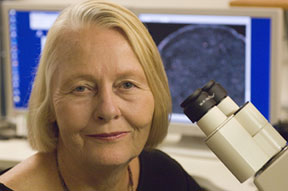 |
 |
|
 |
 |
 |
 |
 |
|
 |
 |
 |
 |

 |
 |
 |
 |

|
 |
Return to Table of Contents
 |
|
|
Nina Strömgren Allen
|
|
In Profile:
Nina Strömgren Allen: MBL Alumna; Course Instructor; and Former Trustee, Executive Committee Member, and Research Committee Chair
“I enjoy beautiful things. And there is nothing more beautiful than many of the images and motions you can see through the microscope,” says Nina Strömgren Allen, a botanist and North Carolina State University (N.C. State) professor whose pursuit of beauty and science have made her a leader in the field of cell motility and imaging. She has been coming to MBL every summer since 1969.
Recently, Allen’s friends, family, and colleagues (including several from the MBL) celebrated her achievements on her 70th birthday with a symposium at N.C. State titled “Imaging: Integrating Across Disciplines.”
Over her lifetime, Allen has learned a lot about beauty and science. The daughter of astronomer Bengt Strömgren, who was the resident director of the Royal Observatory at the University of Copenhagen, her family lived amidst the Royal Botanical Gardens and often entertained famous astronomers and scientists. Her father also provided her with stunning views of Saturn and the moon through professional-strength telescopes at a young age.
With access to so many plants and powerful lenses, it’s not surprising that Allen eventually became a botanist who specializes in microscopy. “When I was little, I thought all plants had labels and just learned their names and families without effort,” she says. “And a telescope is just a microscope in reverse.”
In college, Allen got an A in Astronomy but saw no women in the field. So she pursued chemistry and biology as an undergraduate at the University of Wisconsin at Madison.
Her early interests in plants and beautiful images resurfaced and merged during graduate school at the University of Maryland (UM). “I wanted to understand cytoplasmic streaming in plant cells,” she says. So she tore apart and rebuilt a microscope to allow adding filters and generating action spectra data and found that blue light stimulated cytoplasmic streaming.
Thanks to one of her UM professors, Allen discovered the MBL as a graduate student in the Marine Botany course. “It was a wonderful place to get to know and hear famous scientists, to work with them in the laboratory, and see real research happening. I heard many good lectures, including one by [famed cell imager] Shinya Inoué,” says Allen, who considers Inoué a mentor.
Another of Allen’s mentors was the late Robert Day Allen, a well-known National Institutes of Health biologist and microscopist with strong MBL ties. The scientists became close collaborators and eventually married. Together, they conducted pioneering experiments in the imaging of living cells using high-resolution video cameras and computers that were being used by astronomers like Nina’s father. In 1981, through work at the MBL with Shinya Inoué and at Dartmouth College, the Allens patented the Allen Video Enhanced Contrast light microscope, or AVEC.
The AVEC is one of a vast list of achievements on Nina Allen’s vitae. At the MBL she served as a trustee and on numerous committees and helped establish a day care program to support working families. With MBL research director Mort Maser, she and Robert Allen also helped found the short course, “Optical Microscopy in the Biomedical Sciences,” and established a light microscopy course whose early instructors included Shinya Inoué, Ernst Keller, and Jan Hinsch. “These two short courses were the first of their kind and led to further year-round use of the institution,” Allen says.
At N.C. State, Allen directs the Cellular and Molecular Imaging Facility and has directed the graduate program in Botany for many years. She is now the Chair of Faculty. A strong proponent of women in science, she was an early member of Women in Cell Biology, which she chaired. Allen was also elected a fellow of the AAAS in 1990, and recently published a paper in PNAS demonstrating that parasitic nematodes use many of the same genes and signaling pathways to invade plants that are used by symbiotic bacteria in establishing the beneficial nodulation process.
This past summer, when Allen was not out in her boat, she spent most of her time in Woods Hole in the MBL library. “For some reason I think better when I sit [in there],” she says. Overall, she credits the MBL as the first place she was recognized as a productive scientist. “It was a place where I felt free to think and explore. It was a place where I raised my children and made friends that I kept over the years,” she says.
Never one to ignore beauty, Allen acknowledges that the beautiful location of the MBL has also been important to her over the years. “The beauty of the place lifts your spirits every time you walk out of a building, and that, too, is important,” she says.
Belated birthday wishes, Nina, from your MBL friends and colleagues. Congratulations on a lifetime of achievements, and thanks for all you’ve done for the MBL. We look forward to seeing you next summer.
|
|
| |
 |
|
 |
 |
|